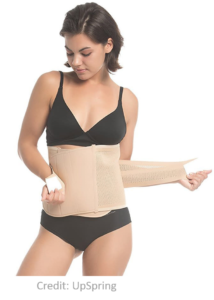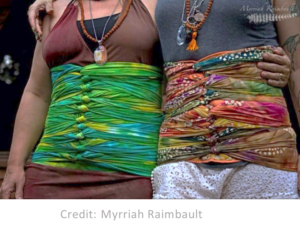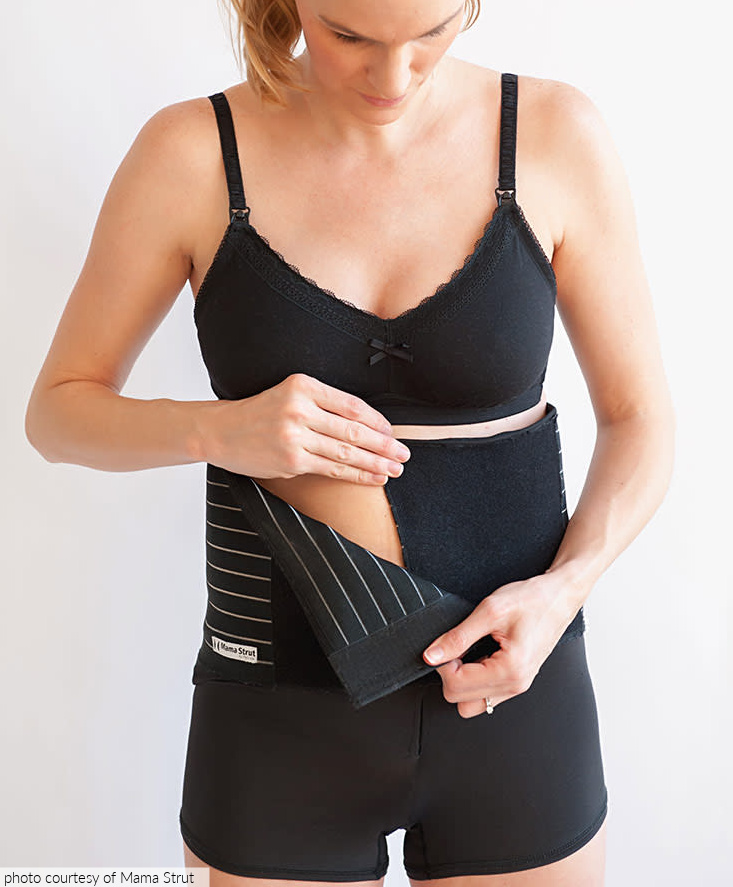To wrap or not to wrap. That is the question. One simple Google search for “postpartum belly wraps” tells you it’s a question a lot of people are asking. But how do you sort through all the conflicting information and compelling ads promising smaller waistlines in no time? How do you know if a postpartum wrap (or binder, or band, or girdle) is right for YOU?
In this piece, we break down the very latest research on wraps — revealing what data has shown (and not shown). We also share guidance from physical therapist and ProNatal Advisory Board Member, Dr. Sneha Gazi, so that you can make the best decision on whether or not a binder makes sense for your personal circumstance. Let’s begin by first defining what we mean by belly wraps.
What is a Belly Wrap?
Typically, belly wraps are designed to be light compression garments that span the area from ribs to hips. You may also hear them referred to as belly binders, abdominal wraps, abdominal binders, or even postpartum girdles. They can be standalone wraps, like below:

They could some as shorts or pants that have extra material to cover the belly, like this:

The material is often elastic, but can also be made from natural fibers like bamboo, cotton, or muslin, like these:

For What Conditions Would a Wrap Be Useful?
During pregnancy, the pelvic and abdominal areas become looser to allow for expansion, in order to carry a progressively larger baby (or babies). After delivery, whether vaginal or C-section, those same areas continue to be quite lax for several weeks. This laxity can lead to low back pain or pelvic pain, such as SI Joint Pain. Abdominal wraps may provide support for low back pain or discomfort in the pelvic region. Wraps may also reduce downward pressure on the pelvic floor, helping to alleviate issues like incontinence. In some Asian, Latin American, and Middle Eastern cultures, wraps are thought to help reduce postpartum bleeding, encourage uterus involution (shrinking), and provide warmth to the healing womb (2).
While the research is light on the subject, it appears that wrapping may help reduce post-operative pain and psychological distress, and provide the support necessary to help you move with greater ease following a C-section delivery (1, 4). Some research showed no improvement on those measures (3) but, anecdotally, wraps seem to provide the wearer with some benefit, as long as they are not so tight that they constrict breathing or movement.
Even though more evidence is needed to form more robust conclusions, especially in those who have delivered vaginally, the results indicate that wraps may be helpful in alleviating acute pain following delivery.
For What Conditions Would a Wrap NOT Be Useful?
While it may be tempting to use wraps for the purpose of speeding postpartum weight loss or shrinking your waistline, there is NO evidence showing that benefit. There is also no evidence at this time showing that wearing a wrap will help diminish or heal the common pregnancy and postpartum issue of abdominal separation, known as Diastasis Recti.
For What Conditions Would a Wrap be Detrimental?
If a wrap is too tight or constricting, it can hinder the ability of the deep core muscles to function properly, and therefore hinder the rebuilding of the deep core. So yes, wearing a very tight binder could actually have the opposite effect of its intended purpose in giving you a flatter tummy. In addition, tight binders may also increase the pressure on the pelvic floor, which could lead to pelvic floor dysfunction. Because of these reasons, we say that the use of any extremely tight girdles or corsets, like the one below, is a clear and unequivocal NO.

The Bottom Line (from a Physical Therapist)
Dr. Sneha Gazi, a physical therapist and ProNatal Advisory Board Member, only recommends wearing a wrap in cases of acute pain or dysfunction. So, if certain activities cause pain, and you find the wrap helpful in alleviating that pain, then use it temporarily while you work on rebuilding your core muscles. Or, if you are going to be doing more strenuous activities (like going on a long walk or wearing your baby for an extended period), and you feel the wrap helps, then use it. However, you never want to use it as a “crutch” and start relying more on your wrap for support than your own body awareness.
The appropriate length of time to wear a wrap varies by individual. If you are in pain, and have no childcare or partner to assist you in baby caring tasks, then you may need to wear it longer. If not, you may only need it for a few days to manage through some minor low back pain or SI joint dysfunction. The important thing is that you do not use it all the time just to feel a little better. “A wrap should never be used as an excuse not to practice moving your body with good mechanics and activating the correct muscles in functional activities,” advises Dr. Gazi.
How to Select a Wrap
If you have decided that you want to try wearing a wrap, make sure to select one that supports with gentle compression, but still allows you to breathe and move comfortably. We recommend the SRC Health recovery garments, as they provide the necessary support to ease comfort without being overly tight or restrictive. You can use code PRONATAL10 for 10% off.
Want Additional Resources?
For additional resources to help you recover, build strength, and get back to doing what you love, explore our Postpartum Training Programs. Or, for a more personalized approach, visit our Find a Coach page to find an expert trainer who can design and coach you through a customized training program.
Are you a Health & Fitness Professional?
If you are a health & fitness professional interested in coaching pre & postnatal clients, explore our ProNatal Education & Certification.
Resources:
- Arici, E., Tastan, S., Can, & M.F. (2006). The effect of using an abdominal binder on postoperative gastrointestinal function, mobilization, pulmonary function, and pain in patients undergoing major abdominal surgery: A randomized controlled trial. International Journal of Nursing Studies, 62, 108-117.
- Dennis, C., Fung, K., Grigoriadis, S., Robinson, G.E., Romans, S., & Ross, L. (2007). Traditional Postpartum Practices and Rituals: A Qualitative Systematic Review. Women’s Health, 3(4), 487–502.
- Gillier, C.M., Sparks, J.R., Kriner, R., & Anasti, J.N. (2016). A randomized controlled trial of abdominal binders for the management of postoperative pain and distress after cesarean delivery. International Journal of Gynecology & Obstetrics, 133 (2), 188-191.
- Saeed, S., Abdullah, R.K., Memon, Siraj, A., Sarah, K., & Ahmed, S.K. (2019). Use of Abdominal Binders after a Major Abdominal Surgery: A Randomized Controlled Trial. Cureus, 11 (10).
Affiliate Notification: The SRC Health link contains an affiliate link. We may earn a commission from purchases made through this link. However, we only endorse companies that we have thoroughly vetted, and believe in.
